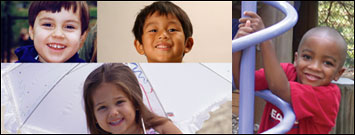Autism Research
 Learn more about the largest collaborative scientific study to date of the risk factors of autism spectrum disorders, CDC's Study to Explore Early Development (also called SEED).
Learn more about the largest collaborative scientific study to date of the risk factors of autism spectrum disorders, CDC's Study to Explore Early Development (also called SEED).
SEED stands for the Study to Explore Early Development. It is a multi-year, multi-site collaborative study that will help identify what might put children at risk for autism spectrum disorders (ASDs) and other developmental disabilities. It is being conducted by up to six study sites and a data coordinating center called the Centers for Autism and Developmental Disabilities Research and Epidemiology (CADDRE) Network.
SEED is looking at risk factors for autism spectrum disorders by:
- Talking with mothers about pregnancy-related issues.
- Looking at the medical records of the mother and child.
- Asking the parents to fill out questionnaires at home.
- Taking cheek swabs from the mother, father, and child.
- Doing a developmental and physical evaluation of the child.
- Taking a small sample of blood from the mother, father, and child.
A number of factors are being studied for their potential link with autism spectrum disorders. These factors were picked after an in-depth look at existing studies. Each factor was chosen as high priority based on:
- How strongly it seemed to be linked with autism spectrum disorders.
- What new information was needed about it.
- How well it could be looked at using this study’s methods.
SEED will:
- Be the largest collaborative scientific study to date of the possible risk factors of autism. It will include over 5,000 children, 2 through 5 years of age, as well as their parents.
- Include diverse groups from different areas across the county. This will give a more representative sample of all children with autism spectrum disorders in the United States.
- Use standard clinical procedures to classify children with and those without autism spectrum disorders.
- Give information on the many things that could lead to autism.
When the study is completed, will we know the causes of autism?
It is too soon to speculate on the results of the study. We hope the study will give us a better idea of which of the risk factors that we will be looking at seem to be the most important in causing autism. The causes may be related to genes, the environment, or a relationship between the two. For instance, some groups of children with certain genes may be more easily harmed by some types of environmental exposures.
Will this study find a prevention/cure for autism?
It is too soon to speculate on what we might find about the risk factors of autism. But, we are hopeful that the findings from SEED will help the development of future studies specifically designed to assess treatments among children with autism.
More Information
Get email updates
To receive email updates about this page, enter your email address:
Contact Us:
- Centers for Disease Control and Prevention
1600 Clifton Rd
Atlanta, GA 30333 - 800-CDC-INFO
(800-232-4636)
TTY: (888) 232-6348 - Contact CDC-INFO



